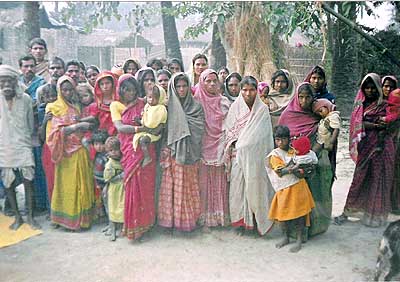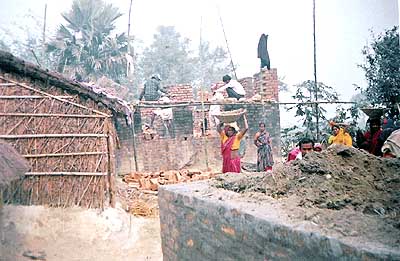In Bela Bichla hamlet (Piprakothi block) of East Champaran district some men and women of Musahar caste are working to raise their houses to a higher level so that these can be protected at the time of next floods. In effect, they are paid the proper, legal wage of Rs. 81 per day to improve their own house.

This became possible because of the availability of ECHO (European Commission Humanitarian Aid Office) aid to Action Aid which has launched a very well-coordinated relief effort in the area. Using resources made available by UNICEF and ECHO, activists of a leading partner of Action Aid, Samajik Shodh Evam Vikas Kendra (SSEVK), worked very hard to take relief materials to remote villages when these were actually needed.

Hamid Raza, an activist of SSEVK recalls, "When we were going by boats to remote villages at night, there were many poisonous snakes the water and on occasions there was a serious risk to our own lives. In dark nights from villages surrounded by water, we used to hear pathetic cries of women and children. These motivated us to keep going there despite all the risks."
Ramkishore Majhi of Bela Bicha says, "Without this help it would have been difficult to survive."
But such is the enormity of the distress, he says, that people of his hamlet still have to migrate to Delhi, Punjab and other distant places to survive.
Amar, Secretary of SSEVK argues, "So great is the distress of people that the relief work has to be stepped up substantially in the winter months maintained at a high level till the rabi crop is harvested in April".
The statistics of the relief provided by Bihar government till Sep. 27 say that a million quintals each of wheat and rice, 9000 quintals of chura and 628 million rupees in cash were provided. This is in addition to air-dropping food packets.
The figures may appear impressive at first glance, but also consider the enormity of the flood disaster - according to official data of same date 23 million people were affected, crops worth Rs. 12884 million were destroyed while damage to houses amounted to Rs. 8422 million.
Inquiries with villagers in 11 rural hamlets revealed that the government aid of one quintal of foodgrain and Rs. 200 in cash has reached people satisfactorily. However as for the crop damage compensation at the rate of Rs. 1600 per acre, this has so far reached only a minority of farmers. Some others hope to get it soon, while some allege problems in getting this relief caused by corruption.
What is most disturbing is that during the last six months people have been deprived of the normal-time benefits of some pro-poor government schemes. As several villagers complained bitterly, during the last six months they did not get subsidised foodgrains in the form of antodya/below poverty line rations. For some time, mid-day meals were also not given to children, although these have been re-started now.
The rural employment guarantee scheme is most needed for such areas of high distress, but during the last six months people of these villages got almost no work under this scheme. As Ramesh Pankaj, Secretary of Muzaffarpur Vikas Mandal, an organisation founded by Jaya Prakash Narayan says, "Even at the time of floods, the affected people could have been provided work in neighbouring areas not affected by floods. If they had got work nearer to their homes, they would not have been forced to migrate to distant areas in conditions of high distress and uncertainty."
next page...Tragedy of Threatened Villages
|